A biologist can understand the life cycle of trees by making observations of many examples of different species of trees, their seeds, saplings, growing conditions, and so on. He or she need not sit in the forest for tens or hundreds of years watching trees grow in order to figure out how trees develop. Similarly, from large samples of different kinds of stars, their parent nebulae, protoplanetary disks, and star-forming environments, astronomers can explain in detail how stars grow. Our own Solar System fits neatly into this picture, and we see all around us the primordial material from which it formed, modified by intervening processes occurring over eons of geological time.

Also like biologists, astronomers analyze samples in the laboratory as well as make studies in the field. Physical, geological, and chemical analysis, including radiometric dating, can tells us the history of the Earth under our feet, as well as inform us about samples obtained from space. These samples range from particles of interplanetary dust collected by high flying aircraft and spacecraft, such as Stardust, that have returned samples to Earth, to the rocks returned from the Moon by the Apollo astronauts, and the rocks that rain down on Earth from space as meteorites.
Explore deep time with the ChronoZoom tool.
Read about Andrew Westphal's work on Stardust in this 2010 NY Times article.
Learn about chunks of the Moon that got blasted into space and ended up on Earth!
